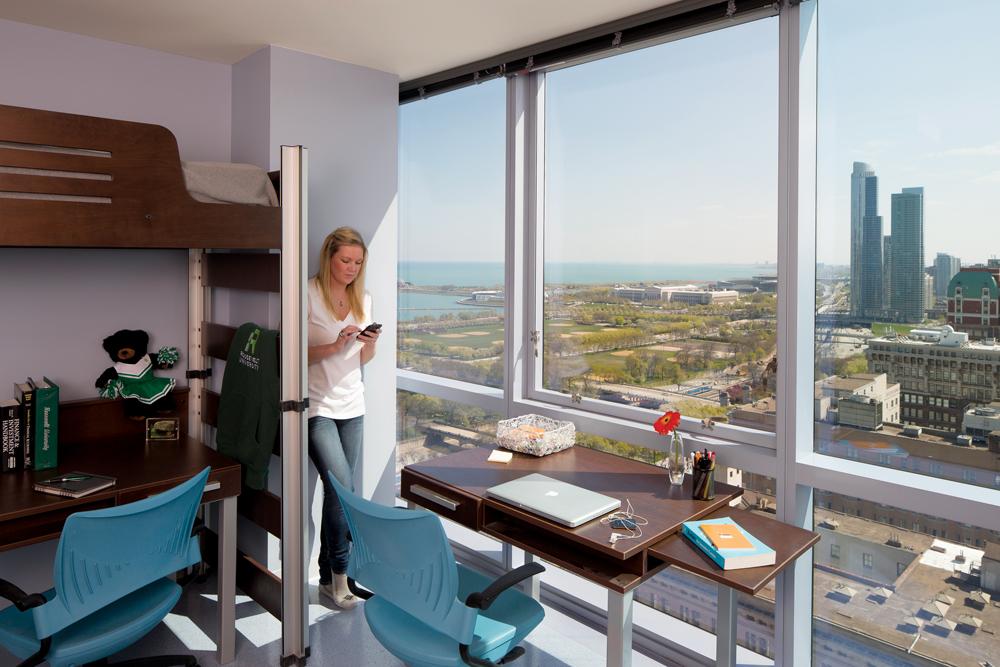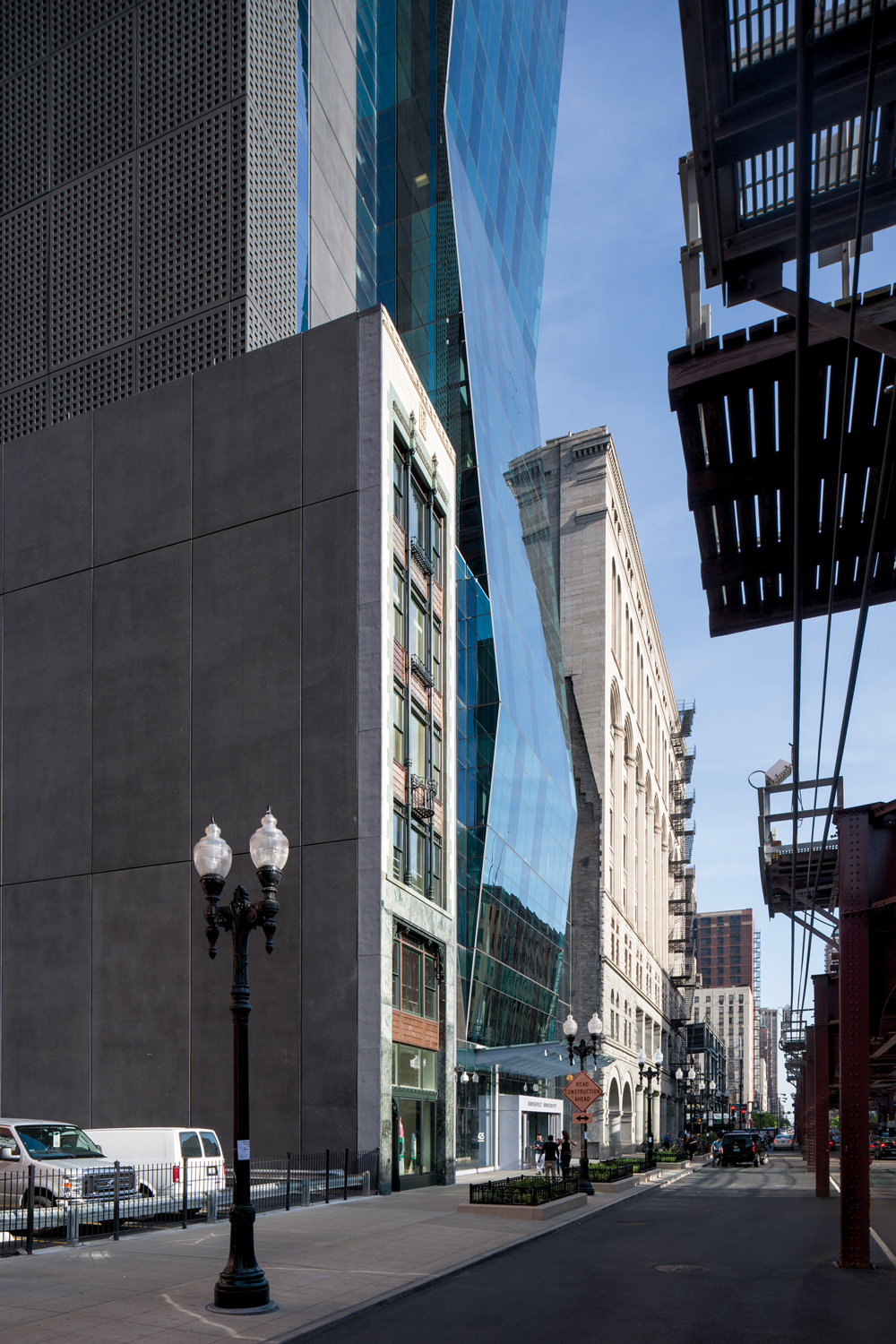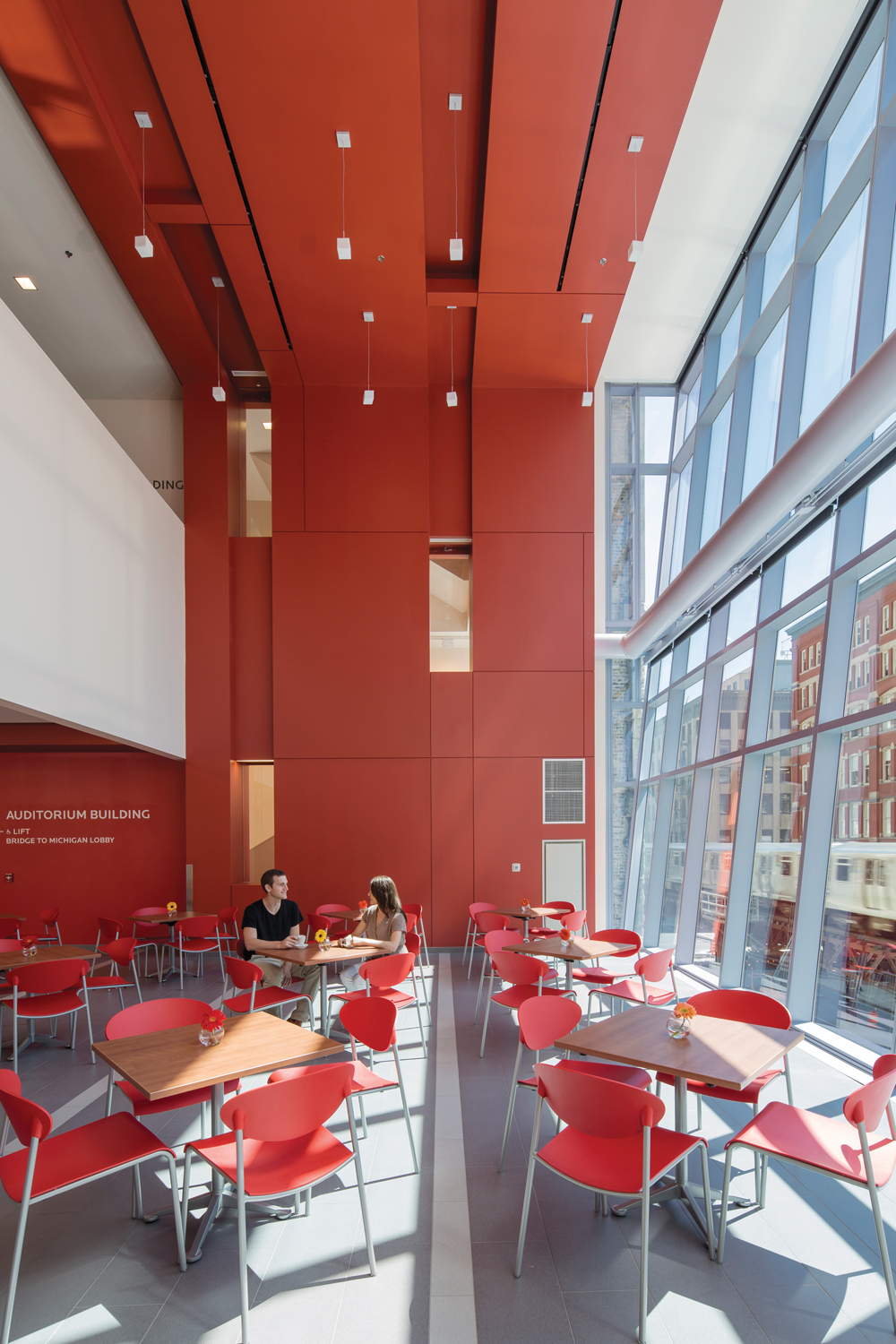Creating a tall facility on a constrained city site always presents special difficulties for Building Teams. Make the program unusually diverse—in this case, combining residential, classroom, laboratory, office, conference, dining, and recreational functions—and the complexity level increases. Now throw in the need to link the facility to a landmark 1880s structure with different floor-to-floor heights. Finally, have the city of Chicago “orange tag” one of two existing buildings on your site, derailing your plans for a complete demolition.
The Building Team for Roosevelt University’s new Wabash Building successfully navigated this minefield, producing a distinctive addition to the South Loop skyline and an appealing new home for the school. Architect VOA Associates, owner’s rep Jones Lang LaSalle, development advisor The John Buck Company, and Power Construction spearheaded a successful functional and aesthetic collaboration that also achieved LEED Gold. The resulting project, at 469 feet in height, is the second-tallest university facility in the U.S. and the sixth-tallest in the world.
From the start, the project was vastly more complex than anything the client had ever attempted. Roosevelt was already occupying the Auditorium Building, a Michigan Avenue icon designed by Adler and Sullivan, as well as a suburban extension campus. To support enrollment growth and program expansion, the university decided to create a tall building that would consolidate many functions while integrating well with the Auditorium.
Student residences include 633 beds on 17 floors, mostly in four- and five-person suites consisting of single and double bedrooms sharing a bathroom. Laundry facilities on the 15th floor feature Internet tracking so students can make sure washers and dryers are available before making the trek. Each residential floor has a large study room with breathtaking lake and city views.
With a footprint of only 17,300 sf, the tight site would need to accommodate a program of ~420,000 sf. A nondescript ’70s high-rise Roosevelt had once used for a dorm was demolished. The attractive façade of the adjacent Fine Arts Annex, a slender six-story structure built in the 1920s, was saved to become the front of a student bookstore.
The design solution created a “servant-served” spatial relationship, placing core and support (“servant”) spaces on the north elevation behind a fairly plain precast concrete façade, with unglazed lower floors giving way to a checkerboard window grid higher up. The functional (“served”) spaces are situated on the south side, featuring blue glass and dramatic canted faces inspired by Brancusi’s famed Endless Column sculpture, as well as the faceted façade of the nearby Spertus Institute of Jewish Studies. The servant-served arrangement maximizes spectacular views to the south, east, and west.
Common areas are clustered in the five lowest floors, including a two-story atrium lobby, student services offices, a student union, a dining hall, and a recreation facility. Classroom and lab spaces and a mechanical floor occupy the midsection, topped by 17 stories of residences.
The servant-served organization maximizes clear spans for the large classrooms and labs, including seven classrooms with a capacity of 36 students each, four tiered classrooms seating 60 to 80, and three auditorium classrooms seating 78 to 180. Judiciously placed prefunction spaces serve as interior “quads” for student interaction.
The façade of the slender 1920s building in the foreground was preserved as the front of a new bookstore. The dark, plain north elevation of the new tower, which faces another tall building, delineates the service functions on this side.
Three stories of science labs support instruction and research in biology, chemistry, and physics, as well as office space for science faculty. Roosevelt’s Heller College of Business was also moved to the new skyscraper from a different Loop facility; its students now benefit from a simulated financial trading room and retail store.
Vertical and horizontal circulation within the Roosevelt campus is necessarily complex. Round-the-clock security check-in is required at Floor 14 before students can proceed to the higher levels via dedicated elevators. Hooking the tower onto the Auditorium Building to the south was also tricky but crucial; the older building is still heavily used for classrooms and offices, as well as performances in beautifully restored ArtNouveau theater spaces. Gently sloping hallways now connect the buildings at four points, with generous signage provided to ease wayfinding.
Getting to LEED Gold required an imaginative mix of strategies, from the typical— high-efficiency HVAC, low-flow plumbing, green roofs—to the less common. In the latter category: removable pillow-tops to maximize mattress life cycle, façade patterning intended to deter bird collisions, a food pulper that allows dining hall waste to be hauled off and composted, and a complex network of recycling chutes with an anti-microbial washdown system.
The second-floor dining center seats 300 and offers a mini-mart for snacks and sundries, as well as cold carryout items, hot food, pizza, a deli, a grill station, and a coffee shop.
Structural and logistical issues demanded creative solutions as well, particularly with respect to crane deployment. Many projects on tight urban sites are built around a central crane, resulting in the need to finish the resulting “dead zone” after the crane is dismantled near the end of the job. Engineering-intensive lab spaces in the Wabash Building’s midsection made this scenario particularly unpalatable. Instead, the Building Team devised a method for mounting the crane outside the building footprint, using counterbalance weights and a crane elevator that hugged the façade.
Today, the Wabash Building is a lively, 24/7 community that brings the school’s social justice mission to life, hosting students from 34 states and more than a dozen countries. Chicago Tribune architecture critic Blair Kamin is among the admirers of Roosevelt’s bold experiment: “It achieves a genuine, artful dialogue between past and present … a building of considerable promise.”
This tiered classroom is one of several large, general instructional spaces provided in the building’s middle floors. Thoughtfully planned daylighting is a hallmark of the project.
Project summary
GOLD AWARD
Roosevelt University Wabash Building
Chicago
BUILDING TEAM
Submitting firms: VOA Associates (architect) and Jones Lang Lasalle (owner’s rep)
Development advisor: The John Buck Company
Associate architect: Johnson & Lee Ltd.
Structural: Magnusson Klemencic Associates
MEP: WMA Consulting Engineers
Contractor: Power Construction
GENERAL INFORMATION
Project size: 420,000 sf
Construction cost: $123 million
Construction time: November 2009 (demolition) to March 2012 (completion)
Delivery method: Design/bid/build
Related Stories
Office Buildings | Mar 21, 2024
BOMA updates floor measurement standard for office buildings
The Building Owners and Managers Association (BOMA) International has released its latest floor measurement standard for office buildings, BOMA 2024 for Office Buildings – ANSI/BOMA Z65.1-2024.
Healthcare Facilities | Mar 18, 2024
A modular construction solution to the mental healthcare crisis
Maria Ionescu, Senior Medical Planner, Stantec, shares a tested solution for the overburdened emergency department: Modular hub-and-spoke design.
Codes and Standards | Mar 18, 2024
New urban stormwater policies treat rainwater as a resource
U.S. cities are revamping how they handle stormwater to reduce flooding and capture rainfall and recharge aquifers. New policies reflect a change in mindset from treating stormwater as a nuisance to be quickly diverted away to capturing it as a resource.
Plumbing | Mar 18, 2024
EPA to revise criteria for WaterSense faucets and faucet accessories
The U.S. Environmental Protection Agency (EPA) plans to revise its criteria for faucets and faucet accessories to earn the WaterSense label. The specification launched in 2007; since then, most faucets now sold in the U.S. meet or exceed the current WaterSense maximum flow rate of 1.5 gallons per minute (gpm).
MFPRO+ New Projects | Mar 18, 2024
Luxury apartments in New York restore and renovate a century-old residential building
COOKFOX Architects has completed a luxury apartment building at 378 West End Avenue in New York City. The project restored and renovated the original residence built in 1915, while extending a new structure east on West 78th Street.
Multifamily Housing | Mar 18, 2024
YWCA building in Boston’s Back Bay converted into 210 affordable rental apartments
Renovation of YWCA at 140 Clarendon Street will serve 111 previously unhoused families and individuals.
Healthcare Facilities | Mar 17, 2024
5 criteria to optimize medical office design
Healthcare designers need to consider privacy, separate areas for practitioners, natural light, outdoor spaces, and thoughtful selection of materials for medical office buildings.
Construction Costs | Mar 15, 2024
Retail center construction costs for 2024
Data from Gordian shows the most recent costs per square foot for restaurants, social clubs, one-story department stores, retail stores and movie theaters in select cities.
Architects | Mar 15, 2024
4 ways to streamline your architectural practice
Vessel Architecture's Lindsay Straatmann highlights four habits that have helped her discover the key to mastering efficiency as an architect.
Healthcare Facilities | Mar 15, 2024
First comprehensive cancer hospital in Dubai to host specialized multidisciplinary care
Stantec was selected to lead the design team for the Hamdan Bin Rashid Cancer Hospital, Dubai’s first integrated, comprehensive cancer hospital. Named in honor of the late Sheikh Hamdan Bin Rashid Al Maktoum, the hospital is scheduled to open to patients in 2026.





















